Business Strategy Evaluation: A Case Study on Nike (574)
VerifiedAdded on 2021/10/04
|24
|7243
|382
Report
AI Summary
This report, prepared for Deloitte LLP, conducts a comprehensive audit of Nike's external environment. It begins with an overview of Nike's mission, vision, and objectives, followed by a discussion of business strategy's definition, role, and models. The report then applies PESTEL analysis to assess the macro-environment, and Porter's Five Forces to evaluate the industry landscape. Stakeholder mapping is used to identify key groups and their influence. The analysis identifies opportunities and threats faced by Nike, culminating in strategic recommendations for the company. The report also includes critical success factors and key drivers of change in the fashion industry, providing a well-rounded view of Nike's strategic context and future direction.
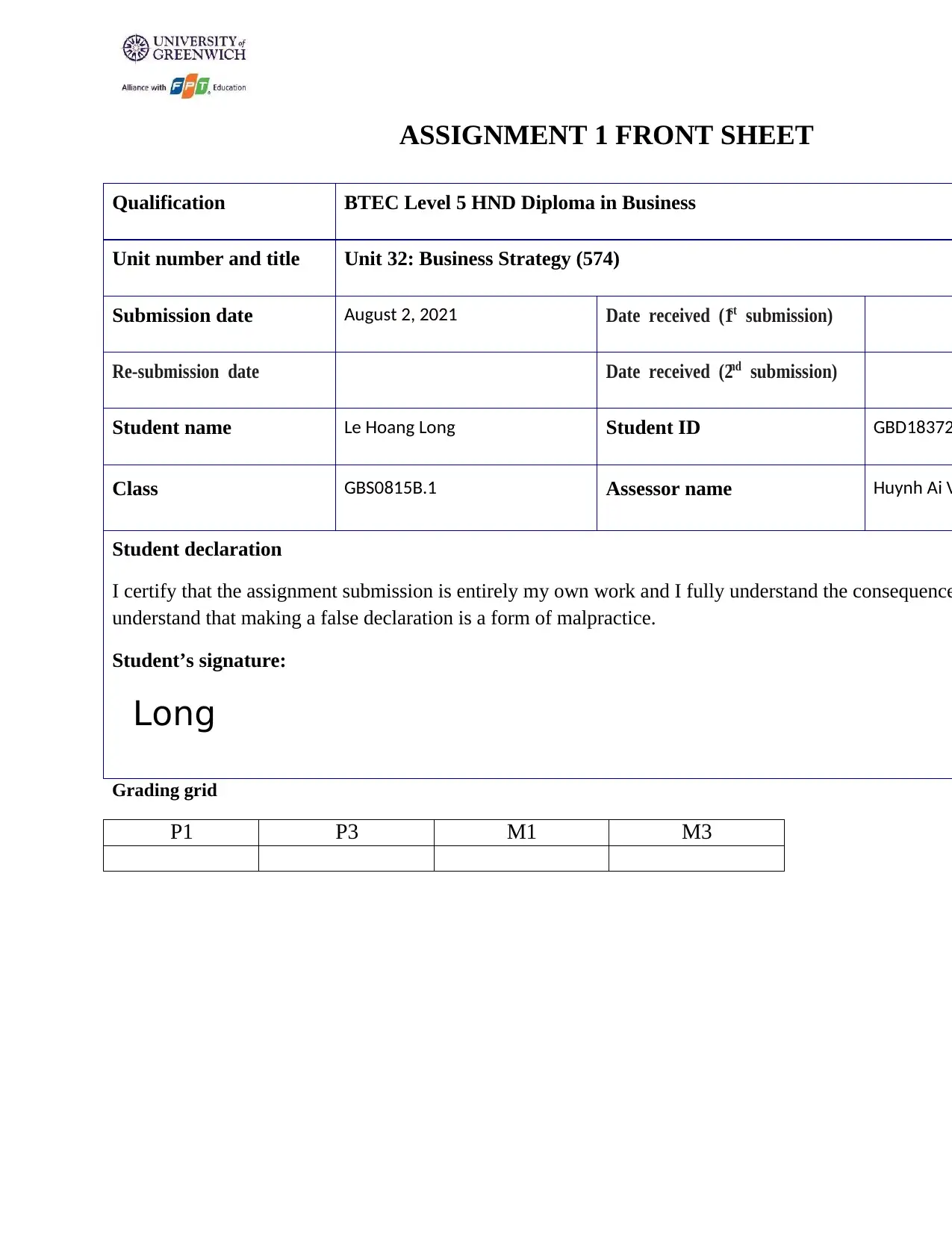
ASSIGNMENT 1 FRONT SHEET
Qualification BTEC Level 5 HND Diploma in Business
Unit number and title Unit 32: Business Strategy (574)
Submission date August 2, 2021 Date received (1st submission)
Re-submission date Date received (2nd submission)
Student name Le Hoang Long Student ID GBD18372
Class GBS0815B.1 Assessor name Huynh Ai V
Student declaration
I certify that the assignment submission is entirely my own work and I fully understand the consequence
understand that making a false declaration is a form of malpractice.
Student’s signature:
Long
Grading grid
P1 P3 M1 M3
Qualification BTEC Level 5 HND Diploma in Business
Unit number and title Unit 32: Business Strategy (574)
Submission date August 2, 2021 Date received (1st submission)
Re-submission date Date received (2nd submission)
Student name Le Hoang Long Student ID GBD18372
Class GBS0815B.1 Assessor name Huynh Ai V
Student declaration
I certify that the assignment submission is entirely my own work and I fully understand the consequence
understand that making a false declaration is a form of malpractice.
Student’s signature:
Long
Grading grid
P1 P3 M1 M3
Paraphrase This Document
Need a fresh take? Get an instant paraphrase of this document with our AI Paraphraser
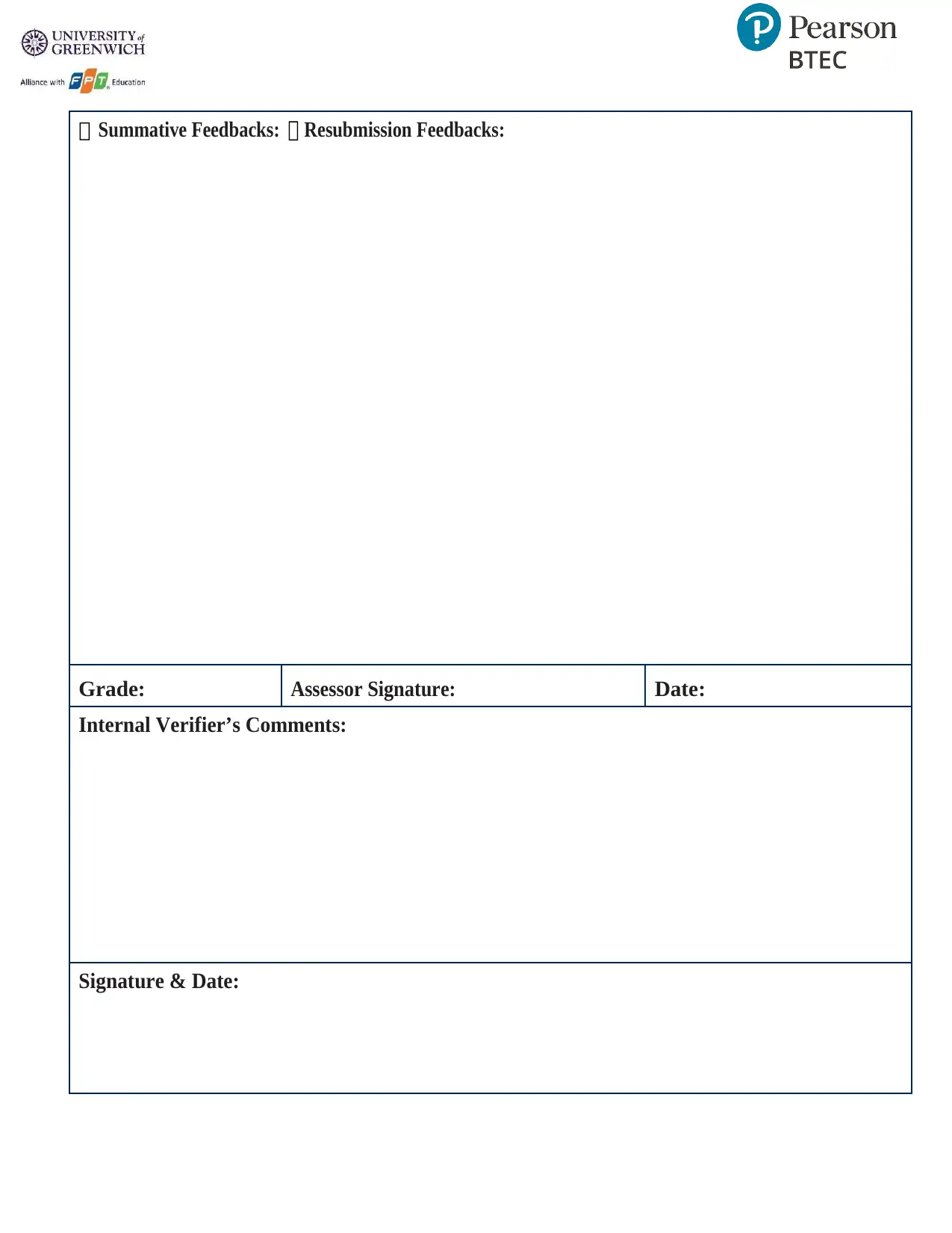
Summative Feedbacks: Resubmission Feedbacks:
Grade: Assessor Signature: Date:
Internal Verifier’s Comments:
Signature & Date:
Grade: Assessor Signature: Date:
Internal Verifier’s Comments:
Signature & Date:
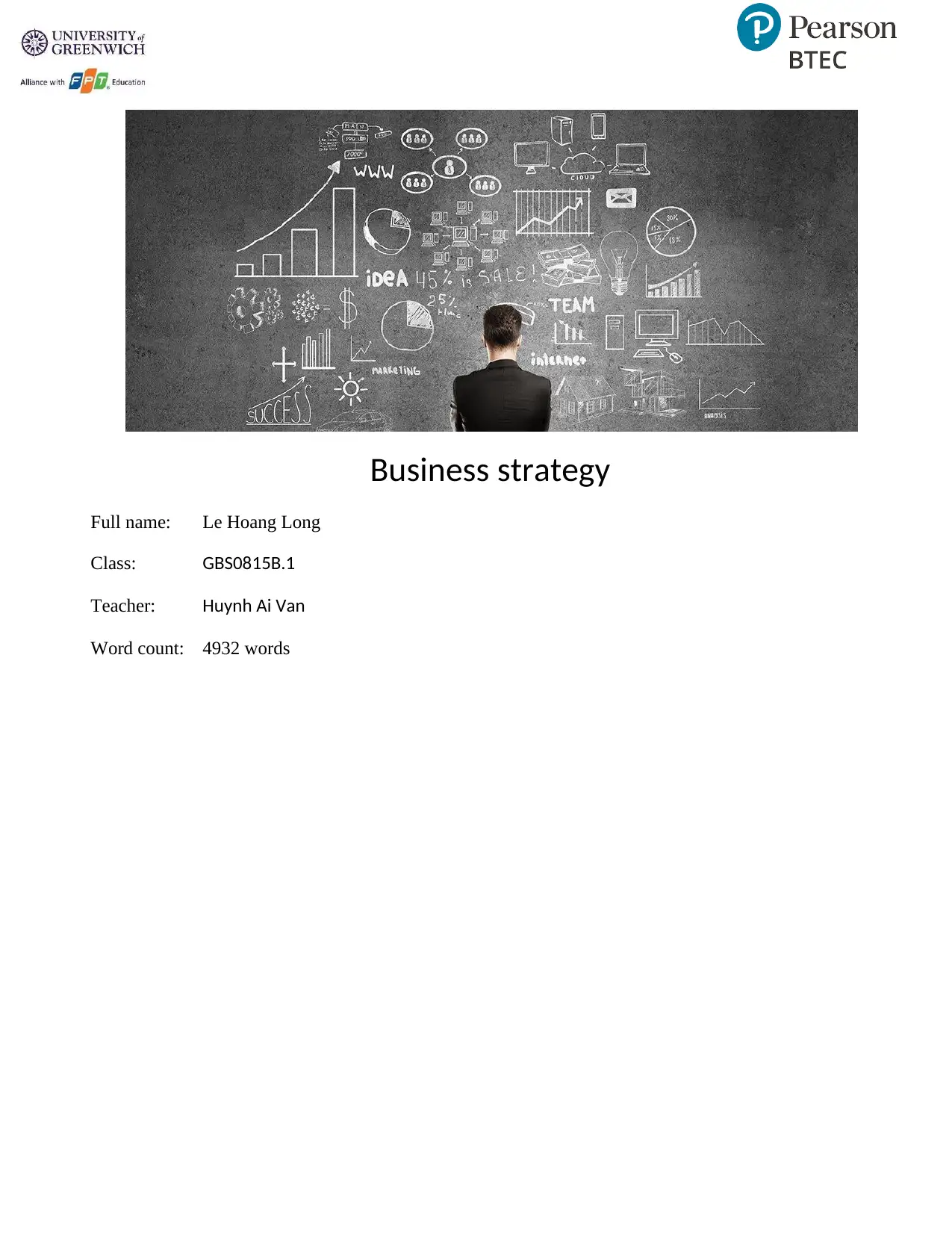
Business strategy
Full name: Le Hoang Long
Class: GBS0815B.1
Teacher: Huynh Ai Van
Word count: 4932 words
Full name: Le Hoang Long
Class: GBS0815B.1
Teacher: Huynh Ai Van
Word count: 4932 words
⊘ This is a preview!⊘
Do you want full access?
Subscribe today to unlock all pages.

Trusted by 1+ million students worldwide
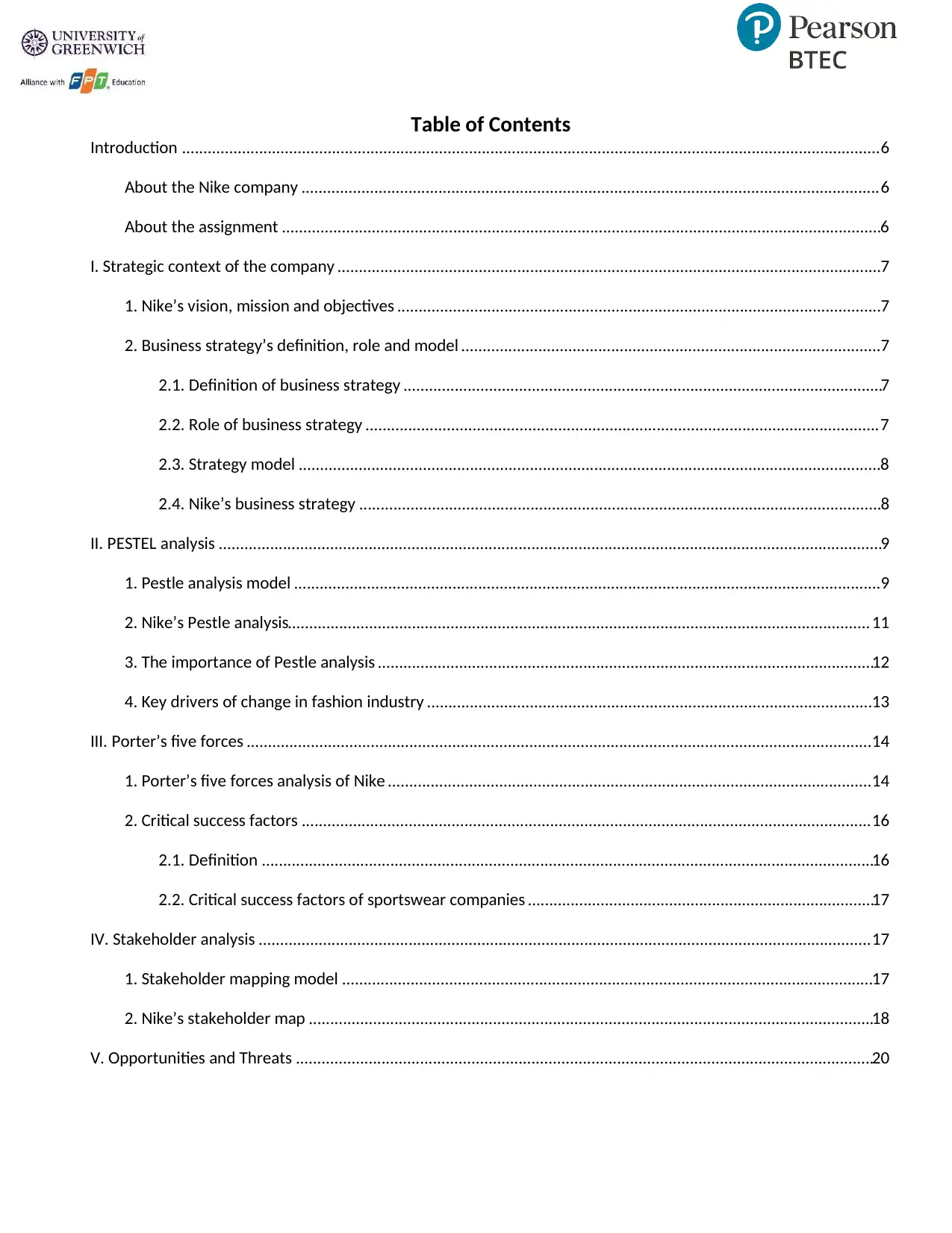
Table of Contents
Introduction ................................................................................................................................................................... 6
About the Nike company ....................................................................................................................................... 6
About the assignment ............................................................................................................................................6
I. Strategic context of the company ...............................................................................................................................7
1. Nike’s vision, mission and objectives .................................................................................................................7
2. Business strategy’s definition, role and model ..................................................................................................7
2.1. Definition of business strategy ................................................................................................................7
2.2. Role of business strategy ........................................................................................................................ 7
2.3. Strategy model ........................................................................................................................................8
2.4. Nike’s business strategy ..........................................................................................................................8
II. PESTEL analysis ...........................................................................................................................................................9
1. Pestle analysis model .........................................................................................................................................9
2. Nike’s Pestle analysis........................................................................................................................................ 11
3. The importance of Pestle analysis ....................................................................................................................12
4. Key drivers of change in fashion industry ........................................................................................................13
III. Porter’s five forces ..................................................................................................................................................14
1. Porter’s five forces analysis of Nike .................................................................................................................14
2. Critical success factors ..................................................................................................................................... 16
2.1. Definition ...............................................................................................................................................16
2.2. Critical success factors of sportswear companies .................................................................................17
IV. Stakeholder analysis ............................................................................................................................................... 17
1. Stakeholder mapping model ............................................................................................................................17
2. Nike’s stakeholder map ....................................................................................................................................18
V. Opportunities and Threats .......................................................................................................................................20
Introduction ................................................................................................................................................................... 6
About the Nike company ....................................................................................................................................... 6
About the assignment ............................................................................................................................................6
I. Strategic context of the company ...............................................................................................................................7
1. Nike’s vision, mission and objectives .................................................................................................................7
2. Business strategy’s definition, role and model ..................................................................................................7
2.1. Definition of business strategy ................................................................................................................7
2.2. Role of business strategy ........................................................................................................................ 7
2.3. Strategy model ........................................................................................................................................8
2.4. Nike’s business strategy ..........................................................................................................................8
II. PESTEL analysis ...........................................................................................................................................................9
1. Pestle analysis model .........................................................................................................................................9
2. Nike’s Pestle analysis........................................................................................................................................ 11
3. The importance of Pestle analysis ....................................................................................................................12
4. Key drivers of change in fashion industry ........................................................................................................13
III. Porter’s five forces ..................................................................................................................................................14
1. Porter’s five forces analysis of Nike .................................................................................................................14
2. Critical success factors ..................................................................................................................................... 16
2.1. Definition ...............................................................................................................................................16
2.2. Critical success factors of sportswear companies .................................................................................17
IV. Stakeholder analysis ............................................................................................................................................... 17
1. Stakeholder mapping model ............................................................................................................................17
2. Nike’s stakeholder map ....................................................................................................................................18
V. Opportunities and Threats .......................................................................................................................................20
Paraphrase This Document
Need a fresh take? Get an instant paraphrase of this document with our AI Paraphraser
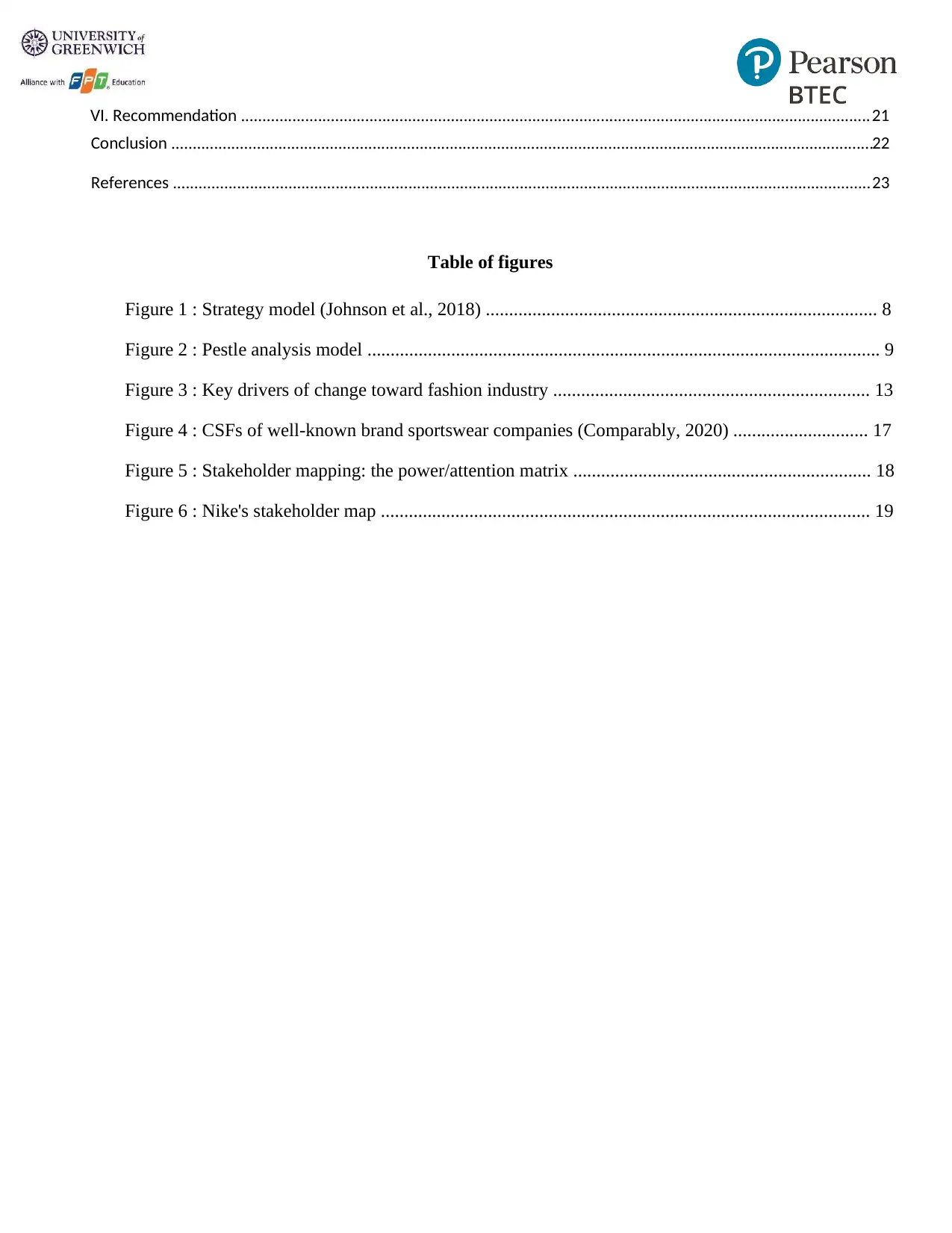
VI. Recommendation ................................................................................................................................................... 21
Conclusion ....................................................................................................................................................................22
References ................................................................................................................................................................... 23
Table of figures
Figure 1 : Strategy model (Johnson et al., 2018) .................................................................................... 8
Figure 2 : Pestle analysis model .............................................................................................................. 9
Figure 3 : Key drivers of change toward fashion industry .................................................................... 13
Figure 4 : CSFs of well-known brand sportswear companies (Comparably, 2020) ............................. 17
Figure 5 : Stakeholder mapping: the power/attention matrix ................................................................ 18
Figure 6 : Nike's stakeholder map ......................................................................................................... 19
Conclusion ....................................................................................................................................................................22
References ................................................................................................................................................................... 23
Table of figures
Figure 1 : Strategy model (Johnson et al., 2018) .................................................................................... 8
Figure 2 : Pestle analysis model .............................................................................................................. 9
Figure 3 : Key drivers of change toward fashion industry .................................................................... 13
Figure 4 : CSFs of well-known brand sportswear companies (Comparably, 2020) ............................. 17
Figure 5 : Stakeholder mapping: the power/attention matrix ................................................................ 18
Figure 6 : Nike's stakeholder map ......................................................................................................... 19
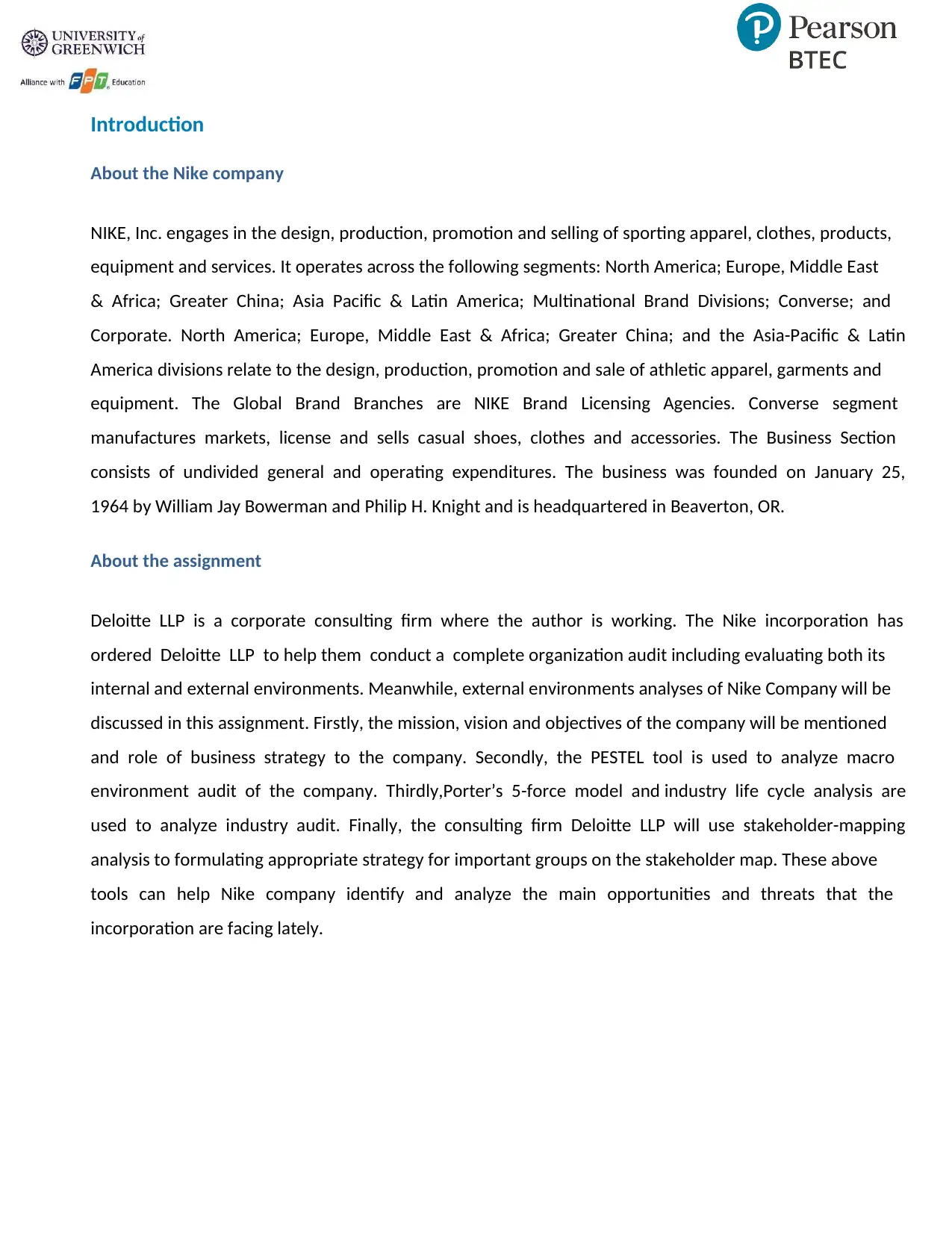
Introduction
About the Nike company
NIKE, Inc. engages in the design, production, promotion and selling of sporting apparel, clothes, products,
equipment and services. It operates across the following segments: North America; Europe, Middle East
& Africa; Greater China; Asia Pacific & Latin America; Multinational Brand Divisions; Converse; and
Corporate. North America; Europe, Middle East & Africa; Greater China; and the Asia-Pacific & Latin
America divisions relate to the design, production, promotion and sale of athletic apparel, garments and
equipment. The Global Brand Branches are NIKE Brand Licensing Agencies. Converse segment
manufactures markets, license and sells casual shoes, clothes and accessories. The Business Section
consists of undivided general and operating expenditures. The business was founded on January 25,
1964 by William Jay Bowerman and Philip H. Knight and is headquartered in Beaverton, OR.
About the assignment
Deloitte LLP is a corporate consulting firm where the author is working. The Nike incorporation has
ordered Deloitte LLP to help them conduct a complete organization audit including evaluating both its
internal and external environments. Meanwhile, external environments analyses of Nike Company will be
discussed in this assignment. Firstly, the mission, vision and objectives of the company will be mentioned
and role of business strategy to the company. Secondly, the PESTEL tool is used to analyze macro
environment audit of the company. Thirdly,Porter’s 5-force model and industry life cycle analysis are
used to analyze industry audit. Finally, the consulting firm Deloitte LLP will use stakeholder-mapping
analysis to formulating appropriate strategy for important groups on the stakeholder map. These above
tools can help Nike company identify and analyze the main opportunities and threats that the
incorporation are facing lately.
About the Nike company
NIKE, Inc. engages in the design, production, promotion and selling of sporting apparel, clothes, products,
equipment and services. It operates across the following segments: North America; Europe, Middle East
& Africa; Greater China; Asia Pacific & Latin America; Multinational Brand Divisions; Converse; and
Corporate. North America; Europe, Middle East & Africa; Greater China; and the Asia-Pacific & Latin
America divisions relate to the design, production, promotion and sale of athletic apparel, garments and
equipment. The Global Brand Branches are NIKE Brand Licensing Agencies. Converse segment
manufactures markets, license and sells casual shoes, clothes and accessories. The Business Section
consists of undivided general and operating expenditures. The business was founded on January 25,
1964 by William Jay Bowerman and Philip H. Knight and is headquartered in Beaverton, OR.
About the assignment
Deloitte LLP is a corporate consulting firm where the author is working. The Nike incorporation has
ordered Deloitte LLP to help them conduct a complete organization audit including evaluating both its
internal and external environments. Meanwhile, external environments analyses of Nike Company will be
discussed in this assignment. Firstly, the mission, vision and objectives of the company will be mentioned
and role of business strategy to the company. Secondly, the PESTEL tool is used to analyze macro
environment audit of the company. Thirdly,Porter’s 5-force model and industry life cycle analysis are
used to analyze industry audit. Finally, the consulting firm Deloitte LLP will use stakeholder-mapping
analysis to formulating appropriate strategy for important groups on the stakeholder map. These above
tools can help Nike company identify and analyze the main opportunities and threats that the
incorporation are facing lately.
⊘ This is a preview!⊘
Do you want full access?
Subscribe today to unlock all pages.

Trusted by 1+ million students worldwide
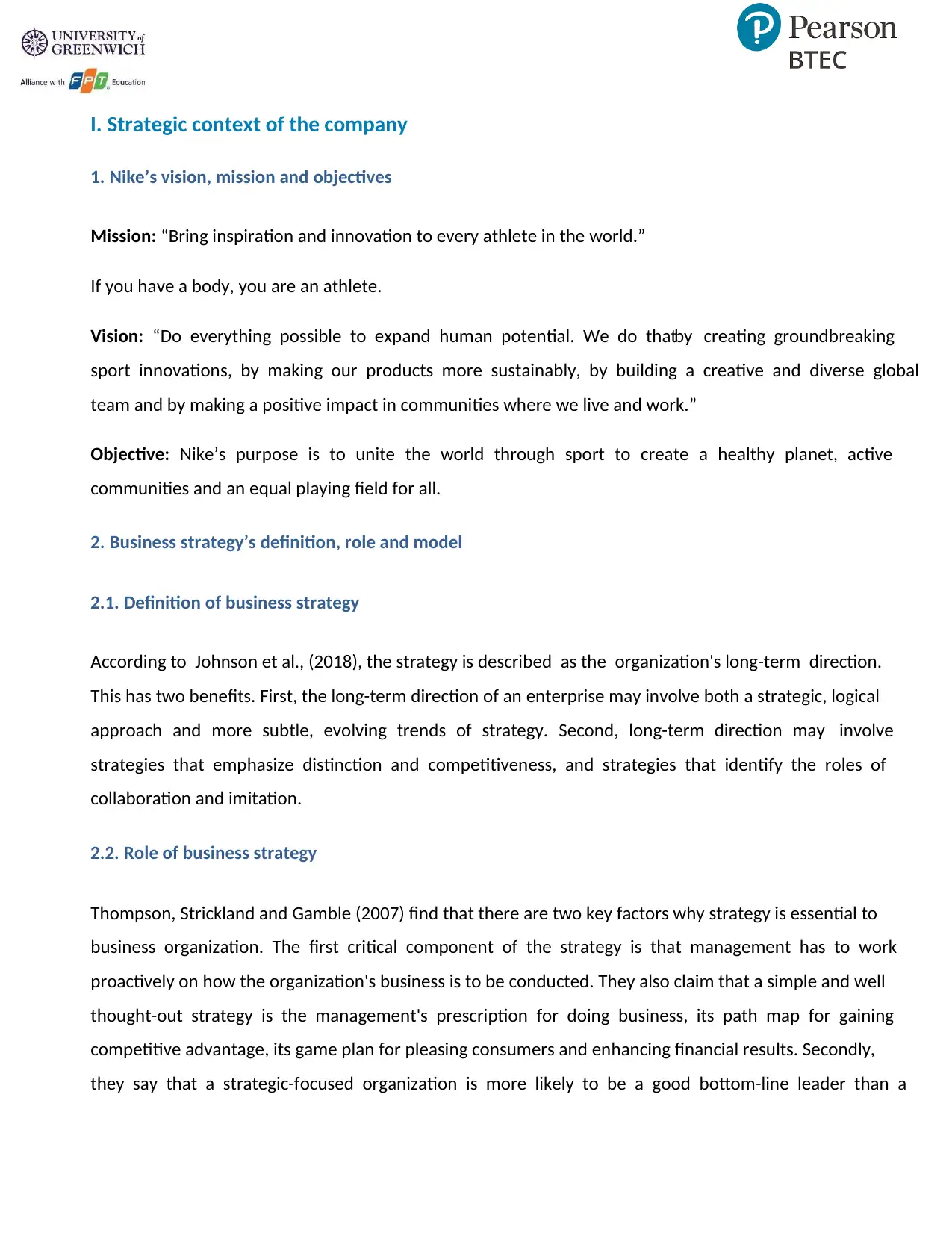
I. Strategic context of the company
1. Nike’s vision, mission and objectives
Mission: “Bring inspiration and innovation to every athlete in the world.”
If you have a body, you are an athlete.
Vision: “Do everything possible to expand human potential. We do thatby creating groundbreaking
sport innovations, by making our products more sustainably, by building a creative and diverse global
team and by making a positive impact in communities where we live and work.”
Objective: Nike’s purpose is to unite the world through sport to create a healthy planet, active
communities and an equal playing field for all.
2. Business strategy’s definition, role and model
2.1. Definition of business strategy
According to Johnson et al., (2018), the strategy is described as the organization's long-term direction.
This has two benefits. First, the long-term direction of an enterprise may involve both a strategic, logical
approach and more subtle, evolving trends of strategy. Second, long-term direction may involve
strategies that emphasize distinction and competitiveness, and strategies that identify the roles of
collaboration and imitation.
2.2. Role of business strategy
Thompson, Strickland and Gamble (2007) find that there are two key factors why strategy is essential to
business organization. The first critical component of the strategy is that management has to work
proactively on how the organization's business is to be conducted. They also claim that a simple and well
thought-out strategy is the management's prescription for doing business, its path map for gaining
competitive advantage, its game plan for pleasing consumers and enhancing financial results. Secondly,
they say that a strategic-focused organization is more likely to be a good bottom-line leader than a
1. Nike’s vision, mission and objectives
Mission: “Bring inspiration and innovation to every athlete in the world.”
If you have a body, you are an athlete.
Vision: “Do everything possible to expand human potential. We do thatby creating groundbreaking
sport innovations, by making our products more sustainably, by building a creative and diverse global
team and by making a positive impact in communities where we live and work.”
Objective: Nike’s purpose is to unite the world through sport to create a healthy planet, active
communities and an equal playing field for all.
2. Business strategy’s definition, role and model
2.1. Definition of business strategy
According to Johnson et al., (2018), the strategy is described as the organization's long-term direction.
This has two benefits. First, the long-term direction of an enterprise may involve both a strategic, logical
approach and more subtle, evolving trends of strategy. Second, long-term direction may involve
strategies that emphasize distinction and competitiveness, and strategies that identify the roles of
collaboration and imitation.
2.2. Role of business strategy
Thompson, Strickland and Gamble (2007) find that there are two key factors why strategy is essential to
business organization. The first critical component of the strategy is that management has to work
proactively on how the organization's business is to be conducted. They also claim that a simple and well
thought-out strategy is the management's prescription for doing business, its path map for gaining
competitive advantage, its game plan for pleasing consumers and enhancing financial results. Secondly,
they say that a strategic-focused organization is more likely to be a good bottom-line leader than a
Paraphrase This Document
Need a fresh take? Get an instant paraphrase of this document with our AI Paraphraser
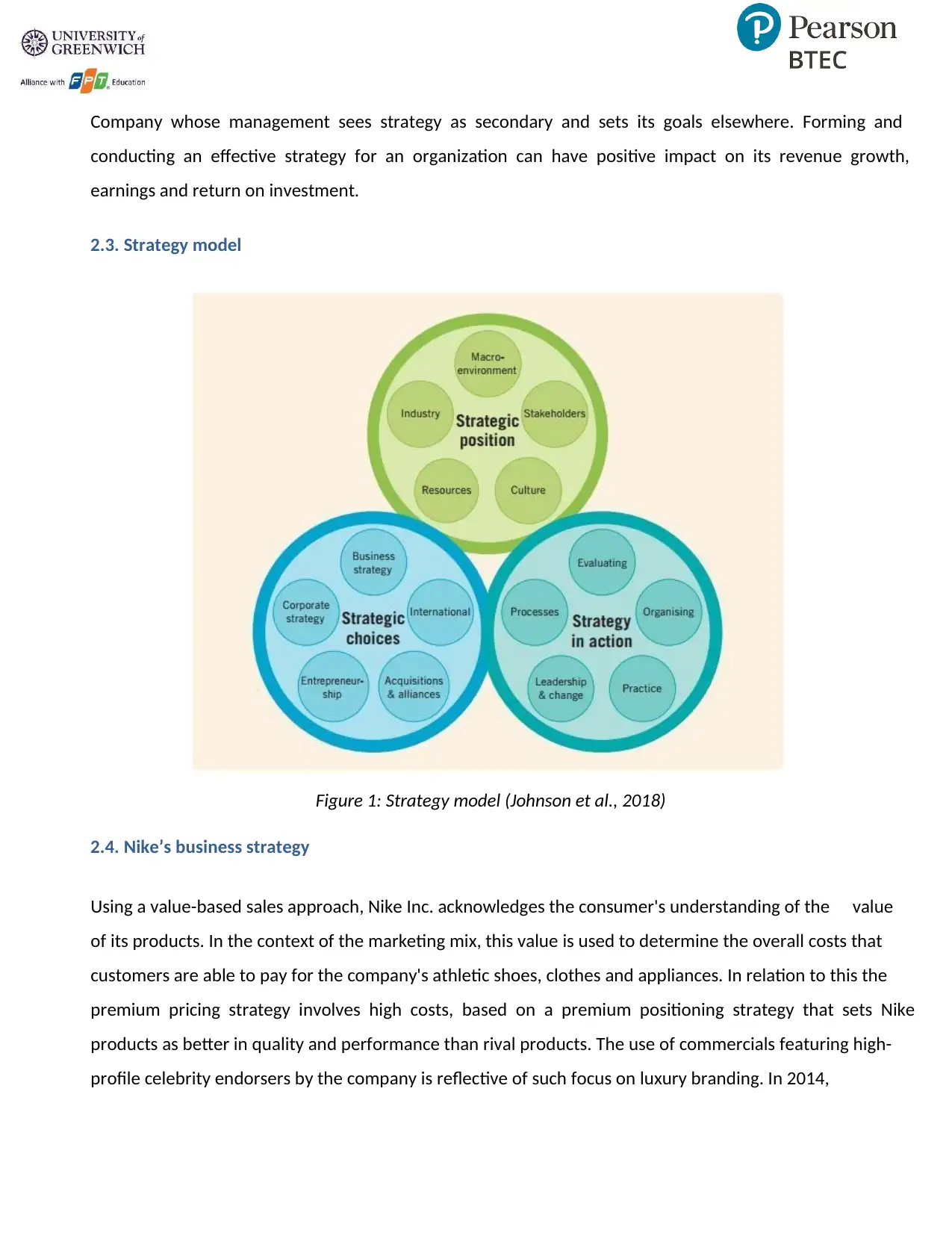
Company whose management sees strategy as secondary and sets its goals elsewhere. Forming and
conducting an effective strategy for an organization can have positive impact on its revenue growth,
earnings and return on investment.
2.3. Strategy model
Figure 1: Strategy model (Johnson et al., 2018)
2.4. Nike’s business strategy
Using a value-based sales approach, Nike Inc. acknowledges the consumer's understanding of the value
of its products. In the context of the marketing mix, this value is used to determine the overall costs that
customers are able to pay for the company's athletic shoes, clothes and appliances. In relation to this the
premium pricing strategy involves high costs, based on a premium positioning strategy that sets Nike
products as better in quality and performance than rival products. The use of commercials featuring high-
profile celebrity endorsers by the company is reflective of such focus on luxury branding. In 2014,
conducting an effective strategy for an organization can have positive impact on its revenue growth,
earnings and return on investment.
2.3. Strategy model
Figure 1: Strategy model (Johnson et al., 2018)
2.4. Nike’s business strategy
Using a value-based sales approach, Nike Inc. acknowledges the consumer's understanding of the value
of its products. In the context of the marketing mix, this value is used to determine the overall costs that
customers are able to pay for the company's athletic shoes, clothes and appliances. In relation to this the
premium pricing strategy involves high costs, based on a premium positioning strategy that sets Nike
products as better in quality and performance than rival products. The use of commercials featuring high-
profile celebrity endorsers by the company is reflective of such focus on luxury branding. In 2014,
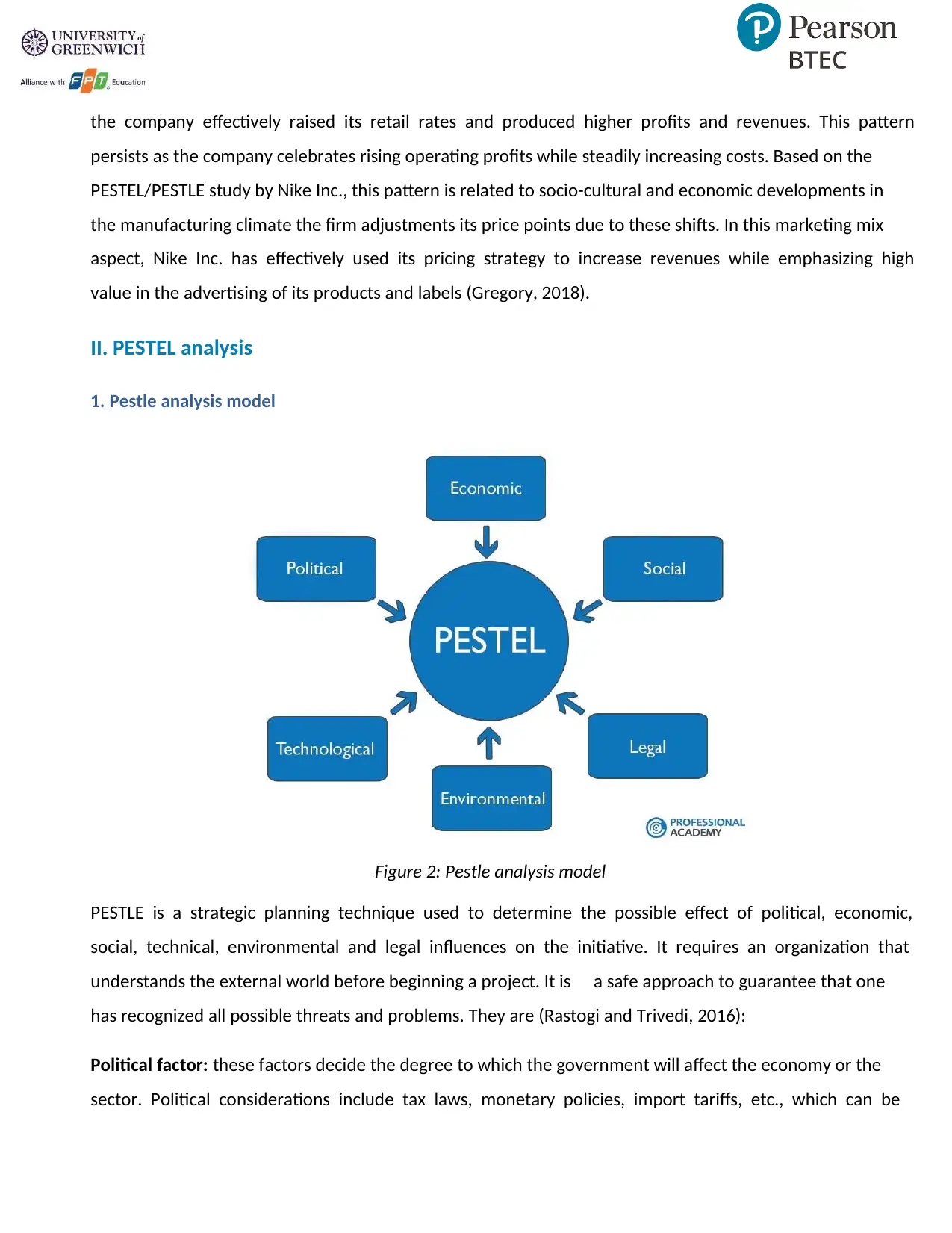
the company effectively raised its retail rates and produced higher profits and revenues. This pattern
persists as the company celebrates rising operating profits while steadily increasing costs. Based on the
PESTEL/PESTLE study by Nike Inc., this pattern is related to socio-cultural and economic developments in
the manufacturing climate the firm adjustments its price points due to these shifts. In this marketing mix
aspect, Nike Inc. has effectively used its pricing strategy to increase revenues while emphasizing high
value in the advertising of its products and labels (Gregory, 2018).
II. PESTEL analysis
1. Pestle analysis model
Figure 2: Pestle analysis model
PESTLE is a strategic planning technique used to determine the possible effect of political, economic,
social, technical, environmental and legal influences on the initiative. It requires an organization that
understands the external world before beginning a project. It is a safe approach to guarantee that one
has recognized all possible threats and problems. They are (Rastogi and Trivedi, 2016):
Political factor: these factors decide the degree to which the government will affect the economy or the
sector. Political considerations include tax laws, monetary policies, import tariffs, etc., which can be
persists as the company celebrates rising operating profits while steadily increasing costs. Based on the
PESTEL/PESTLE study by Nike Inc., this pattern is related to socio-cultural and economic developments in
the manufacturing climate the firm adjustments its price points due to these shifts. In this marketing mix
aspect, Nike Inc. has effectively used its pricing strategy to increase revenues while emphasizing high
value in the advertising of its products and labels (Gregory, 2018).
II. PESTEL analysis
1. Pestle analysis model
Figure 2: Pestle analysis model
PESTLE is a strategic planning technique used to determine the possible effect of political, economic,
social, technical, environmental and legal influences on the initiative. It requires an organization that
understands the external world before beginning a project. It is a safe approach to guarantee that one
has recognized all possible threats and problems. They are (Rastogi and Trivedi, 2016):
Political factor: these factors decide the degree to which the government will affect the economy or the
sector. Political considerations include tax laws, monetary policies, import tariffs, etc., which can be
⊘ This is a preview!⊘
Do you want full access?
Subscribe today to unlock all pages.

Trusted by 1+ million students worldwide
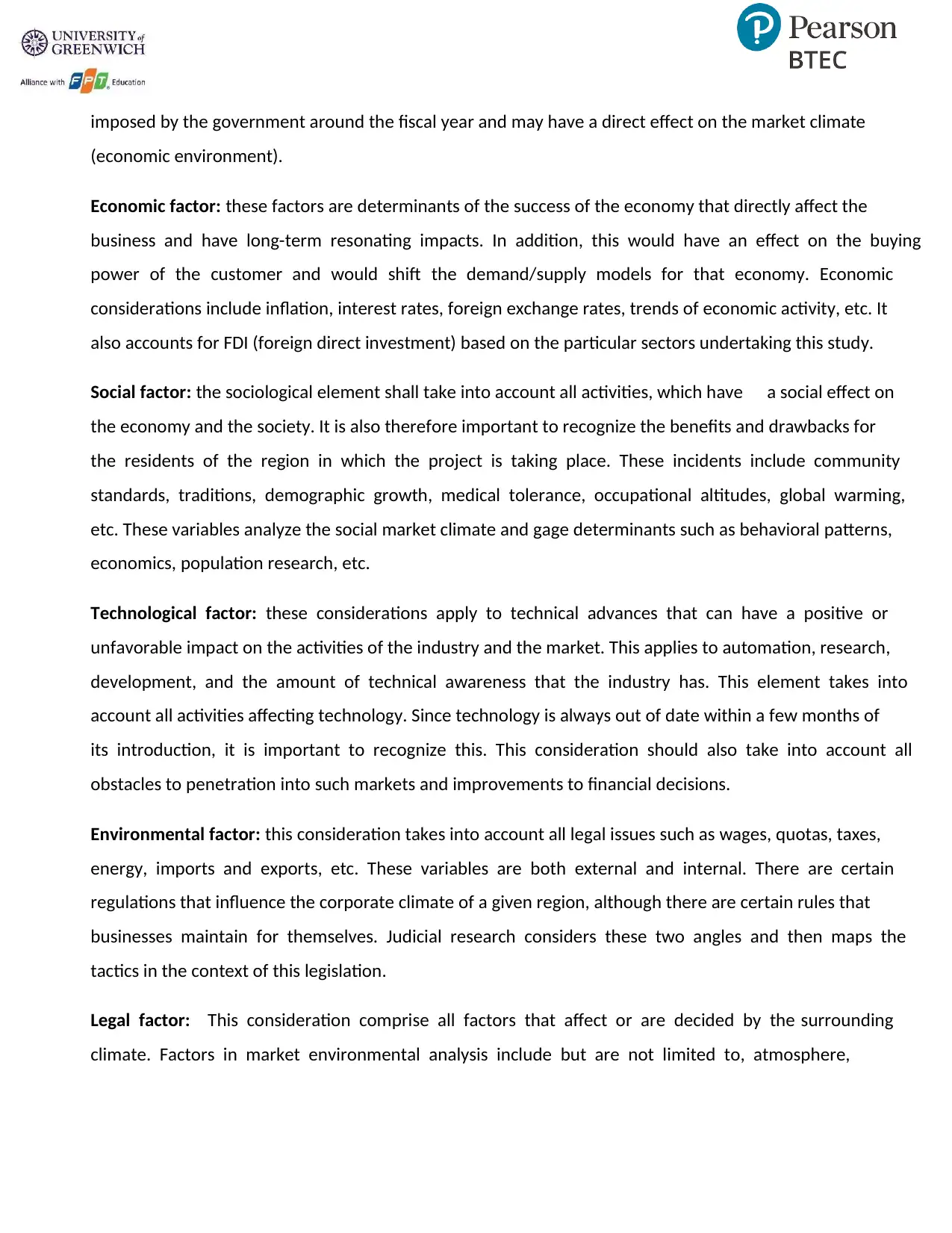
imposed by the government around the fiscal year and may have a direct effect on the market climate
(economic environment).
Economic factor: these factors are determinants of the success of the economy that directly affect the
business and have long-term resonating impacts. In addition, this would have an effect on the buying
power of the customer and would shift the demand/supply models for that economy. Economic
considerations include inflation, interest rates, foreign exchange rates, trends of economic activity, etc. It
also accounts for FDI (foreign direct investment) based on the particular sectors undertaking this study.
Social factor: the sociological element shall take into account all activities, which have a social effect on
the economy and the society. It is also therefore important to recognize the benefits and drawbacks for
the residents of the region in which the project is taking place. These incidents include community
standards, traditions, demographic growth, medical tolerance, occupational altitudes, global warming,
etc. These variables analyze the social market climate and gage determinants such as behavioral patterns,
economics, population research, etc.
Technological factor: these considerations apply to technical advances that can have a positive or
unfavorable impact on the activities of the industry and the market. This applies to automation, research,
development, and the amount of technical awareness that the industry has. This element takes into
account all activities affecting technology. Since technology is always out of date within a few months of
its introduction, it is important to recognize this. This consideration should also take into account all
obstacles to penetration into such markets and improvements to financial decisions.
Environmental factor: this consideration takes into account all legal issues such as wages, quotas, taxes,
energy, imports and exports, etc. These variables are both external and internal. There are certain
regulations that influence the corporate climate of a given region, although there are certain rules that
businesses maintain for themselves. Judicial research considers these two angles and then maps the
tactics in the context of this legislation.
Legal factor: This consideration comprise all factors that affect or are decided by the surrounding
climate. Factors in market environmental analysis include but are not limited to, atmosphere,
(economic environment).
Economic factor: these factors are determinants of the success of the economy that directly affect the
business and have long-term resonating impacts. In addition, this would have an effect on the buying
power of the customer and would shift the demand/supply models for that economy. Economic
considerations include inflation, interest rates, foreign exchange rates, trends of economic activity, etc. It
also accounts for FDI (foreign direct investment) based on the particular sectors undertaking this study.
Social factor: the sociological element shall take into account all activities, which have a social effect on
the economy and the society. It is also therefore important to recognize the benefits and drawbacks for
the residents of the region in which the project is taking place. These incidents include community
standards, traditions, demographic growth, medical tolerance, occupational altitudes, global warming,
etc. These variables analyze the social market climate and gage determinants such as behavioral patterns,
economics, population research, etc.
Technological factor: these considerations apply to technical advances that can have a positive or
unfavorable impact on the activities of the industry and the market. This applies to automation, research,
development, and the amount of technical awareness that the industry has. This element takes into
account all activities affecting technology. Since technology is always out of date within a few months of
its introduction, it is important to recognize this. This consideration should also take into account all
obstacles to penetration into such markets and improvements to financial decisions.
Environmental factor: this consideration takes into account all legal issues such as wages, quotas, taxes,
energy, imports and exports, etc. These variables are both external and internal. There are certain
regulations that influence the corporate climate of a given region, although there are certain rules that
businesses maintain for themselves. Judicial research considers these two angles and then maps the
tactics in the context of this legislation.
Legal factor: This consideration comprise all factors that affect or are decided by the surrounding
climate. Factors in market environmental analysis include but are not limited to, atmosphere,
Paraphrase This Document
Need a fresh take? Get an instant paraphrase of this document with our AI Paraphraser
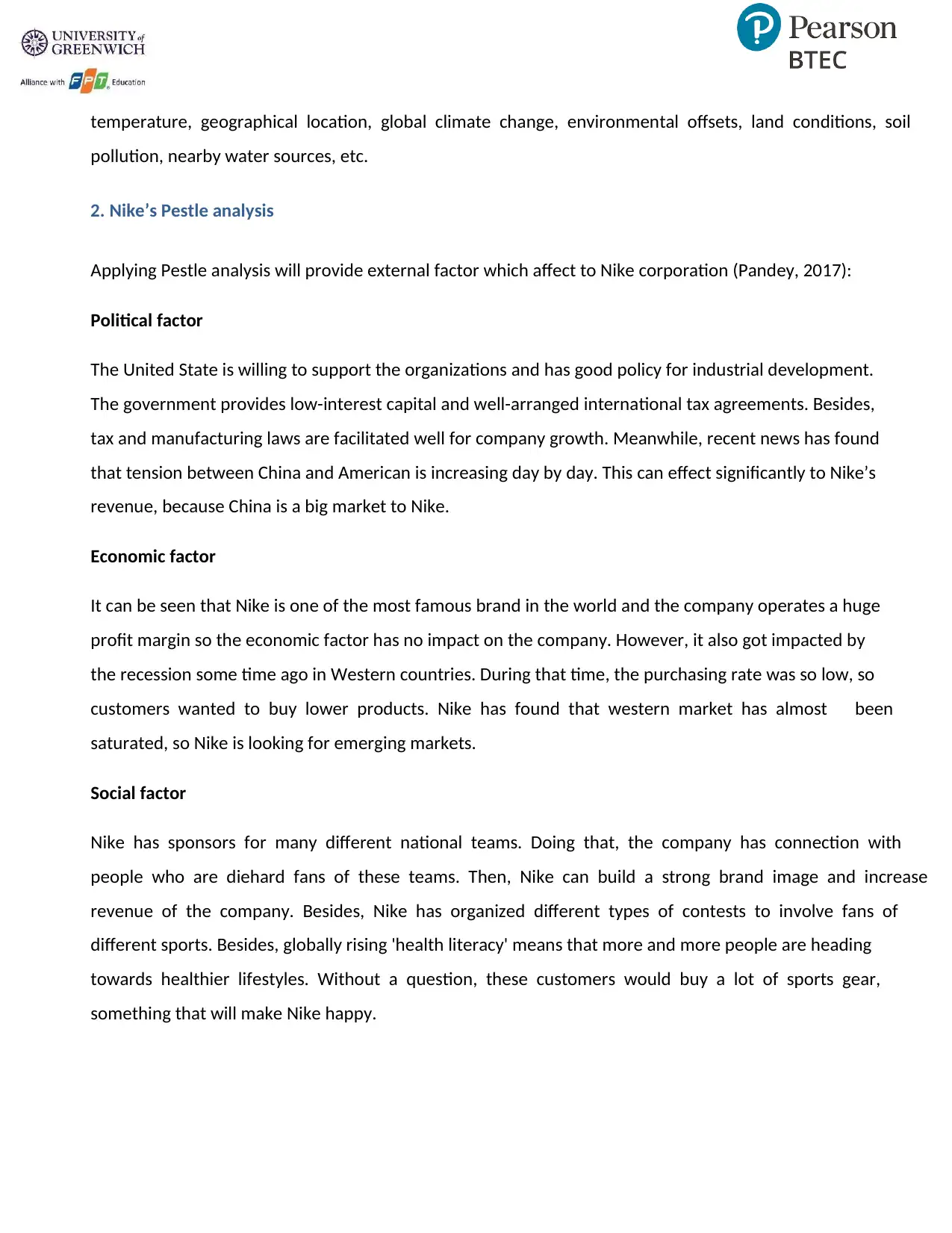
temperature, geographical location, global climate change, environmental offsets, land conditions, soil
pollution, nearby water sources, etc.
2. Nike’s Pestle analysis
Applying Pestle analysis will provide external factor which affect to Nike corporation (Pandey, 2017):
Political factor
The United State is willing to support the organizations and has good policy for industrial development.
The government provides low-interest capital and well-arranged international tax agreements. Besides,
tax and manufacturing laws are facilitated well for company growth. Meanwhile, recent news has found
that tension between China and American is increasing day by day. This can effect significantly to Nike’s
revenue, because China is a big market to Nike.
Economic factor
It can be seen that Nike is one of the most famous brand in the world and the company operates a huge
profit margin so the economic factor has no impact on the company. However, it also got impacted by
the recession some time ago in Western countries. During that time, the purchasing rate was so low, so
customers wanted to buy lower products. Nike has found that western market has almost been
saturated, so Nike is looking for emerging markets.
Social factor
Nike has sponsors for many different national teams. Doing that, the company has connection with
people who are diehard fans of these teams. Then, Nike can build a strong brand image and increase
revenue of the company. Besides, Nike has organized different types of contests to involve fans of
different sports. Besides, globally rising 'health literacy' means that more and more people are heading
towards healthier lifestyles. Without a question, these customers would buy a lot of sports gear,
something that will make Nike happy.
pollution, nearby water sources, etc.
2. Nike’s Pestle analysis
Applying Pestle analysis will provide external factor which affect to Nike corporation (Pandey, 2017):
Political factor
The United State is willing to support the organizations and has good policy for industrial development.
The government provides low-interest capital and well-arranged international tax agreements. Besides,
tax and manufacturing laws are facilitated well for company growth. Meanwhile, recent news has found
that tension between China and American is increasing day by day. This can effect significantly to Nike’s
revenue, because China is a big market to Nike.
Economic factor
It can be seen that Nike is one of the most famous brand in the world and the company operates a huge
profit margin so the economic factor has no impact on the company. However, it also got impacted by
the recession some time ago in Western countries. During that time, the purchasing rate was so low, so
customers wanted to buy lower products. Nike has found that western market has almost been
saturated, so Nike is looking for emerging markets.
Social factor
Nike has sponsors for many different national teams. Doing that, the company has connection with
people who are diehard fans of these teams. Then, Nike can build a strong brand image and increase
revenue of the company. Besides, Nike has organized different types of contests to involve fans of
different sports. Besides, globally rising 'health literacy' means that more and more people are heading
towards healthier lifestyles. Without a question, these customers would buy a lot of sports gear,
something that will make Nike happy.
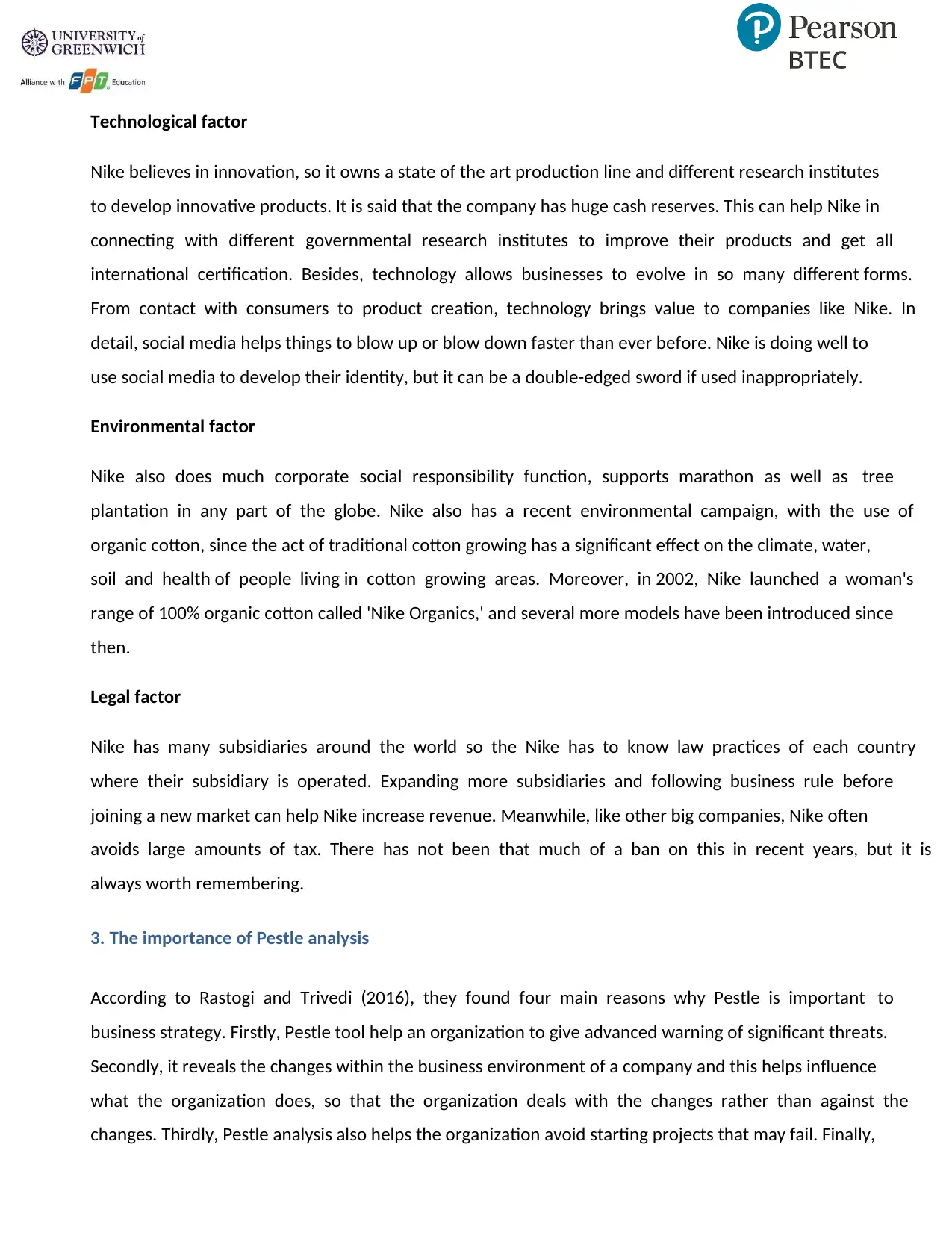
Technological factor
Nike believes in innovation, so it owns a state of the art production line and different research institutes
to develop innovative products. It is said that the company has huge cash reserves. This can help Nike in
connecting with different governmental research institutes to improve their products and get all
international certification. Besides, technology allows businesses to evolve in so many different forms.
From contact with consumers to product creation, technology brings value to companies like Nike. In
detail, social media helps things to blow up or blow down faster than ever before. Nike is doing well to
use social media to develop their identity, but it can be a double-edged sword if used inappropriately.
Environmental factor
Nike also does much corporate social responsibility function, supports marathon as well as tree
plantation in any part of the globe. Nike also has a recent environmental campaign, with the use of
organic cotton, since the act of traditional cotton growing has a significant effect on the climate, water,
soil and health of people living in cotton growing areas. Moreover, in 2002, Nike launched a woman's
range of 100% organic cotton called 'Nike Organics,' and several more models have been introduced since
then.
Legal factor
Nike has many subsidiaries around the world so the Nike has to know law practices of each country
where their subsidiary is operated. Expanding more subsidiaries and following business rule before
joining a new market can help Nike increase revenue. Meanwhile, like other big companies, Nike often
avoids large amounts of tax. There has not been that much of a ban on this in recent years, but it is
always worth remembering.
3. The importance of Pestle analysis
According to Rastogi and Trivedi (2016), they found four main reasons why Pestle is important to
business strategy. Firstly, Pestle tool help an organization to give advanced warning of significant threats.
Secondly, it reveals the changes within the business environment of a company and this helps influence
what the organization does, so that the organization deals with the changes rather than against the
changes. Thirdly, Pestle analysis also helps the organization avoid starting projects that may fail. Finally,
Nike believes in innovation, so it owns a state of the art production line and different research institutes
to develop innovative products. It is said that the company has huge cash reserves. This can help Nike in
connecting with different governmental research institutes to improve their products and get all
international certification. Besides, technology allows businesses to evolve in so many different forms.
From contact with consumers to product creation, technology brings value to companies like Nike. In
detail, social media helps things to blow up or blow down faster than ever before. Nike is doing well to
use social media to develop their identity, but it can be a double-edged sword if used inappropriately.
Environmental factor
Nike also does much corporate social responsibility function, supports marathon as well as tree
plantation in any part of the globe. Nike also has a recent environmental campaign, with the use of
organic cotton, since the act of traditional cotton growing has a significant effect on the climate, water,
soil and health of people living in cotton growing areas. Moreover, in 2002, Nike launched a woman's
range of 100% organic cotton called 'Nike Organics,' and several more models have been introduced since
then.
Legal factor
Nike has many subsidiaries around the world so the Nike has to know law practices of each country
where their subsidiary is operated. Expanding more subsidiaries and following business rule before
joining a new market can help Nike increase revenue. Meanwhile, like other big companies, Nike often
avoids large amounts of tax. There has not been that much of a ban on this in recent years, but it is
always worth remembering.
3. The importance of Pestle analysis
According to Rastogi and Trivedi (2016), they found four main reasons why Pestle is important to
business strategy. Firstly, Pestle tool help an organization to give advanced warning of significant threats.
Secondly, it reveals the changes within the business environment of a company and this helps influence
what the organization does, so that the organization deals with the changes rather than against the
changes. Thirdly, Pestle analysis also helps the organization avoid starting projects that may fail. Finally,
⊘ This is a preview!⊘
Do you want full access?
Subscribe today to unlock all pages.

Trusted by 1+ million students worldwide
1 out of 24
Related Documents
Your All-in-One AI-Powered Toolkit for Academic Success.
+13062052269
info@desklib.com
Available 24*7 on WhatsApp / Email
![[object Object]](/_next/static/media/star-bottom.7253800d.svg)
Unlock your academic potential
Copyright © 2020–2025 A2Z Services. All Rights Reserved. Developed and managed by ZUCOL.




